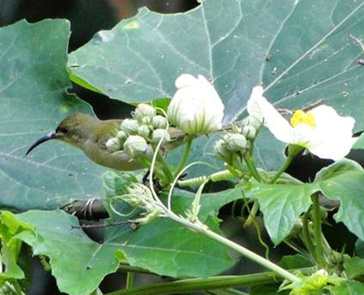Aggressive displacement of Xylocopa nigrita carpenter bees from flowers of Lagenaria sphaerica (Cucurbitaceae) by territorial male Eastern Olive Sunbirds (Cyanomitra olivacea) in Tanzania
DOI:
https://doi.org/10.26786/1920-7603(2013)7Abstract
Male Eastern Olive Sunbirds (Cyanomitra olivacea) and Xylocopa nigrita carpenter bees in Tanzania both utilise the flowers of male plants of Lagenaria sphaerica (Cucurbitaceae) as a source of nectar. The sunbirds set up territories defending this nectar resource. Observations of interactions between the sunbirds and the carpenter bees show that the bees are aggressively displaced from flowers when spotted by the birds. Only the bees can be considered as legitimate pollinators as the birds do not contact the anthers of the male flowers and were never seen visiting nectarless female flowers of Lagenaria sphaerica. Such territory defence may have implications for the frequency of movement and composition of pollen being transferred from male to female flowers which warrants further research.

Downloads
Published
How to Cite
Issue
Section
License
Copyright (c) 2013 Jeff Ollerton, Clive Nuttman

This work is licensed under a Creative Commons Attribution 4.0 International License.
JPE is an open access journal which means that all content is freely available without charge to the user or his/her institution.
Authors who publish with this journal agree to the following terms:
1) Authors retain copyright and grant the journal right of first publication with the work simultaneously licensed under a Creative Commons Attribution License that allows others to share the work with an acknowledgement of the work's authorship and initial publication in this journal.
2) Authors are able to enter into separate, additional contractual arrangements for the non-exclusive distribution of the journal's published version of the work (e.g., post it to an institutional repository or publish it in a book), with an acknowledgement of its initial publication in this journal.
3) Authors are permitted and encouraged to post their work online (e.g., in institutional repositories or on their website) prior to and during the submission process, as it can lead to productive exchanges, as well as earlier and greater citation of published work (See The Effect of Open Access).
To assure a broader targeted audience, content will be included into databases (such as EBSCO) and directories (such as DOAJ).











